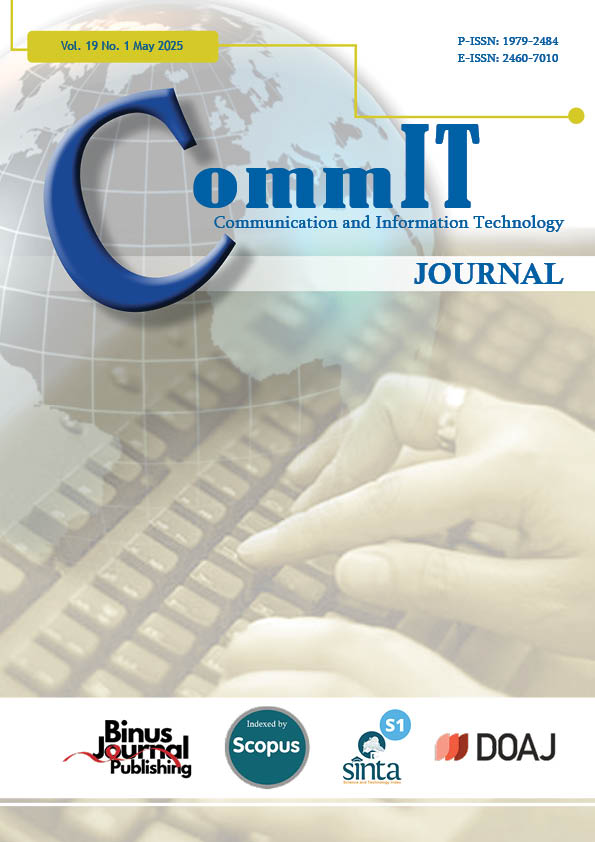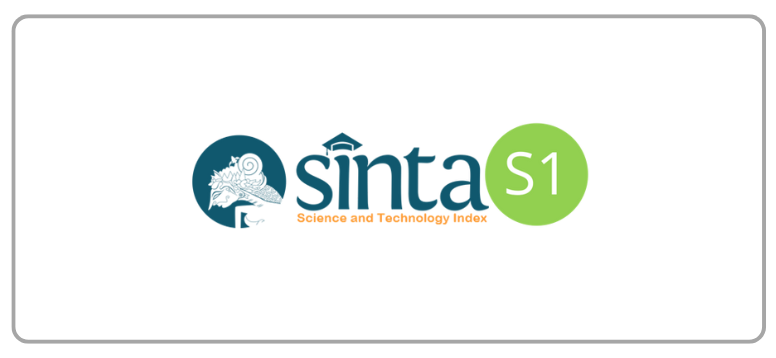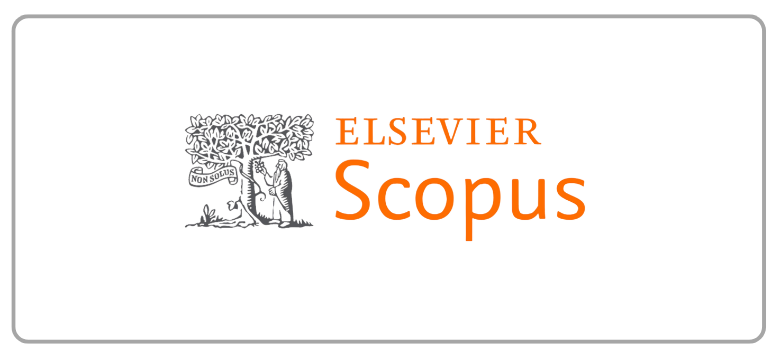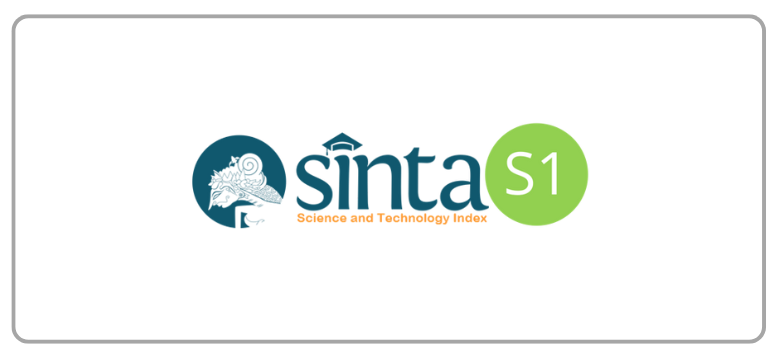Classifying Electroencephalogram (EEG) Signals via Brain Activity Mapping to Distinguish Identified vs Unidentified Information
DOI:
https://doi.org/10.21512/commit.v19i1.12500Keywords:
Electroencephalogram (EEG) Signals, Brain Activity, Identified Information, Unidentified InformationAbstract
Conventional lie detectors have often been questioned for their accuracy and reliability, which can lead to wrongful accusations. These inaccurate results may compromise legal decisions, threaten national security, or hinder the justice system. Electroencephalogram (EEG) is a technique used to record electrical activity in the brain, which has become a major focus for researchers, especially in the development of lie detection systems. Therefore, the research aims to explore complex patterns in brain activity that play an important role in distinguishing identified and unidentified information by using brain activity mapping as a novel approach. The required data are taken from channels T3, T4, T5, T6, O1, and O2 related to human memory. A total of 30 participants are involved in the research, where their brain activity is analyzed in the Alpha, Beta, and Gamma subbands. Brain activity visualization parameters are based on energy wavelet feature extraction values. The visualization results for each participant in the three subbands are then classified using the Na¨ıve Bayes algorithm with a Gaussian distribution approach. The results of the machine learning method achieve 72% accuracy, with test scenarios using 80% training data and 20% testing data. The research introduces brain heat mapping as an innovative visualization technique to interpret EEG-based deception detection better, offering a more intuitive and explainable approach compared to traditional feature-based methods. The findings contribute to a deeper understanding of brain function and provide a foundation for improving the effectiveness and reliability of EEG-based lie detection in investigative contexts.
References
[1] W. Chang, H. Wang, G. Yan, and C. Liu, “An EEG based familiar and unfamiliar person identification and classification system using feature extraction and directed functional brain network,” Expert Systems with Applications, vol. 158, 2020.
[2] Y. Z. Abd El Gawad, M. I. Youssef, and T. M. Nasser, “Medical system based on thermal optical system and neural network,” International Journal of Electrical and Computer Engineering (IJECE), vol. 13, no. 4, pp. 3796–3804, 2023.
[3] J. Immanuel, A. Joshua, and S. T. George, “A study on using blink parameters from EEG data for lie detection,” in 2018 International Conference on Computer Communication and Informatics (ICCCI). Coimbatore, India: IEEE, Jan. 4–6, 2018, pp. 1–5.
[4] N. A. Sayel, B. M. Sabbar, and S. Albermany, “Real time control system for wheel chair of disabled people using EEG signal,” in 2022 4th International Conference on Advanced Science and Engineering (ICOASE). Zakho, Iraq: IEEE, Sep. 21–22, 2022, pp. 71–76.
[5] Y. Pamungkas, A. D. Wibawa, and Y. Rais, “Classification of emotions (positive-negative) based on EEG statistical features using RNN, LSTM, and Bi-LSTM algorithms,” in 2022 2nd International Seminar on Machine Learning, Optimization, and Data Science (ISMODE). Jakarta, Indonesia: IEEE, Sep. 22–23, 2022, pp. 275–280.
[6] Y. Guo, M. Wang, T. Zheng, Y. Li, P. Wang, and X. Qin, “NAO robot limb control method based on motor imagery EEG,” in 2020 International Symposium on Computer, Consumer and Control (IS3C). Taichung City, Taiwan: IEEE, Nov. 13–16, 2020, pp. 521–524.
[7] A. Turnip, M. F. Amri, M. A. Suhendra, and D. E. Kusumandari, “Lie detection based EEG-P300 signal classified by ANFIS method,” Journal of Telecommunication, Electronic and Computer Engineering (JTEC), vol. 9, no. 1-5, pp. 107–110, 2017.
[8] A. I. Simbolon, A. Turnip, J. Hutahaean, Y. Siagian, and N. Irawati, “An experiment of lie detection based EEG-P300 classified by SVM algorithm,” in 2015 International Conference on Automation, Cognitive Science, Optics, Micro Electro-Mechanical System, and Information Technology (ICACOMIT). Bandung, Indonesia: IEEE, Oct. 29–30, 2015, pp. 68–71.
[9] P. V. Ravindran and A. P. Vinod, “Name familiarity detection using EEG-based brain computer interface,” in TENCON 2019-2019 IEEE Region 10 Conference (TENCON). Kochi, India: IEEE, Oct. 17–20, 2019, pp. 2305–2309.
[10] K. G. Smitha, A. P. Vinod, and K. Mahesh, “Voice familiarity detection using EEG-based brain-computer interface,” in 2016 IEEE International Conference on Systems, Man, and Cybernetics (SMC). Budapest, Hungary: IEEE, Oct. 9–12, 2016, pp. 001 626–001 631.
[11] R. Alazrai, R. Homoud, H. Alwanni, and M. I. Daoud, “EEG-based emotion recognition using quadratic time-frequency distribution,” Sensors, vol. 18, no. 8, pp. 1–32, 2018.
[12] K. K. Koganti, S. Kameswari, and V. J. Naveen, “Artifical intelligance based real time lie detector using eye gaze pattern,” in 2022 International Conference on Electronic Systems and Intelligent Computing (ICESIC). Chennai, India: IEEE, April 22–23, 2022, pp. 235–240.
[13] C. H. Ma, H. Y. Chang, H. C. Lee, Y. F. Yu, H. S. Tien, Y. H. Lin, M. Y. Liu, Y. L. Lin, H. M. Ma, K. F. Lin, and H. W. Lieh, “The psychological and physiological effects of integrated cognitivebehavioral and biofeedback therapy on panic disorder: A randomized controlled trial,” Journal of the Formosan Medical Association, vol. 122, no. 12, pp. 1305–1312, 2023.
[14] N. Baghel, D. Singh, M. K. Dutta, R. Burget, and V. Myska, “Truth identification from EEG signal by using convolution neural network: Lie detection,” in 2020 43rd International Conference on Telecommunications and Signal Processing (TSP). Milan, Italy: IEEE, July 7–9, 2020, pp. 550–553.
[15] R. Holker and S. Susan, “Quantitative EEG feature selection by MajorityVoting for alcohol use disorder detection,” in 2021 IEEE EMBS International Conference on Biomedical and Health Informatics (BHI). Athens, Greece: IEEE, July 27–30, 2021, pp. 1–4.
[16] O. K. Cura, S. K. Atli, S. Y. Sen, and A. Akan, “Classification of ADHD by using multiple feature maps of EEG signals and deep feature extraction,” in 2023 31st European Signal Processing Conference (EUSIPCO). Helsinki, Finland: IEEE, Sep. 4–8, 2023, pp. 1065–1069.
[17] X. Xu, F. Wei, Z. Zhu, J. Liu, X. Wu, X. Xu, F. Wei, Z. Zhu, J. Liu, and X. Wu, “EEG feature selection using orthogonal regression: Application to emotion recognition,” in ICASSP 2020 -2020 IEEE International Conference on Acoustics, Speech and Signal Processing (ICASSP). Barcelona, Spain: IEEE, May 4–8, 2020, pp. 1239–1243.
[18] M. Murtazina and T. Avdeenko, “Feature selection techniques analysis for identification of cognitive and resting states based on EEG data,” in 2022 VIII International Conference on Information Technology and Nanotechnology (ITNT). Samara, Russian Federation: IEEE, May 23–27, 2022, pp. 1–4.
[19] M. Huang, L. Ye, J. Chen, R. Fu, and C. Zhou, “Feature representation for meditation state classification in EEG signal,” in 2021 11th International Conference on Information Technology in Medicine and Education (ITME). Fujian, China: IEEE, Nov. 19–21, 2021, pp. 267–270.
[20] A. Farizal, A. D. Wibawa, Y. Pamungkas, M. Pratiwi, and A. Mas, “Classifying known/unknown information in the brain using Electroencephalography (EEG) signal analysis,” in 2022 11th Electrical Power, Electronics, Communications, Controls and Informatics Seminar (EECCIS). Malang, Indonesia: IEEE, Aug. 23–25, 2022, pp. 362–367.
[21] Y. Pamungkas, “Data analytics on EEG signal features to distinguish familiar and unfamiliar information in human brain memory,” in 2023 International Conference on Computer Science, Information Technology and Engineering (ICCoSITE). Jakarta, Indonesia: IEEE, Feb. 16, 2023, pp. 369–374.
[22] S. D. Suryani, A. D. Wibawa, and D. P. Wulandari, “EEG analysis of familiar and unfamiliar objects using wavelet energy and Shannon entropy,” in 2024 16th International Conference on Knowledge and Smart Technology (KST). Krabi, Thailand: IEEE, Feb. 28–March 2, 2024, pp. 226–231.
[23] A. V. Garenskaya, M. A. Bakaev, and O. M. Razumnikova, “Telling minds apart: Classification of EEG signals based on comparison of brain activity maps,” in 2021 XV International Scientific-Technical Conference on Actual Problems of Electronic Instrument Engineering (APEIE). Novosibirsk, Russian Federation: IEEE, Nov. 19–21, 2021, pp. 459–464.
[24] M. G. Puxeddu, M. Petti, and L. Astolfi, “Multilayer analysis of multi-frequency brain networks as a new tool to study EEG topological organization,” in 2021 43rd Annual International Conference of the IEEE Engineering in Medicine & Biology Society (EMBC). Mexico: IEEE, Nov. 1–5, 2021, pp. 924–927.
[25] P. Volf, M. Stehlik, P. Kutilek, G. Kloudova, K. Rusnakova, S. Kozlova, M. Braunova, J. Hejda, V. Krivanek, and R. Doskocil, “Brain electrical activity mapping in military pilots during simulator trainings,” in 2019 International Conference on Military Technologies (ICMT). Brno, Czech Republic: IEEE, May 30–31, 2019, pp. 1–6.
[26] A. Abdalmalak, G. Laforge, L. C. M. Yip, D. Milej, L. E. Gonzalez-Lara, U. Anazodo, A. M. Owen, and K. S. Lawrence, “Shining light on the human brain: An optical BCI for communicating with patients with brain injuries,” in 2020 IEEE International Conference on Systems, Man, and Cybernetics (SMC). ON, Canada: IEEE, Oct. 11–14, 2020, pp. 502–507.
[27] N. Abe, J. Okuda, M. Suzuki, H. Sasaki, T. Matsuda, E. Mori, M. Tsukada, and T. Fujii, “Neural correlates of true memory, false memory, and deception,” Cerebral Cortex, vol. 18, no. 12, pp. 2811–2819, 2008.
[28] D. Risqiwati, A. D. Wibawa, E. S. Pane, E. M. Yuniarno, W. R. Islamiyah, and M. H. Purnomo, “Effective relax acquisition: A novel approach to classify relaxed state in alpha band EEG-based transformation,” Brain Informatics, vol. 11, no. 1, pp. 1–14, 2024.
[29] P. D. Purnamasari and T. W. Junika, “Frequencybased EEG human concentration detection system methods with SVM classification,” in 2019 IEEE International Conference on Cybernetics and Computational Intelligence (CyberneticsCom). Banda Aceh, Indonesia: IEEE, Aug. 22–24, 2019, pp. 29–34.
[30] I. Lakshan, L. Wickramasinghe, S. Disala, S. Chandrasegar, and P. S. Haddela, “Real time deception detection for criminal investigation,” in 2019 National Information Technology Conference (NITC). Colombo, Sri Lanka: IEEE, Oct. 8–10, 2019, pp. 90–96.
[31] Z. Labibah, M. Nasrun, and C. Setianingsih, “Lie detector with the analysis of the change of diameter pupil and the eye movement use method Gabor wavelet transform and decision tree,” in 2018 IEEE International Conference on Internet of Things and Intelligence System (IOTAIS). Bali, Indonesia: IEEE, Nov. 1–3, 2018, pp. 214–220.
[32] L. Ghosh, S. Ghosh, A. Konar, P. Rakshit, and A. K. Nagar, “Decoding of EEG signals using deep long short-term memory network in face recognition task,” in 2018 IEEE Symposium Series on Computational Intelligence (SSCI). Bangalore, India: IEEE, Nov. 18–21, 2018, pp. 477–483.
[33] R. Ismayanti, F. Alameka, D. Mirwansyah, N.W.W. Sari, A. Rahim, and Riyayatsyah, “Identification of pests on black orchid plants using na¨ıve bayes method based on leaf image texture,” in 2022 International Conference of Science and Information Technology in Smart Administration (ICSINTESA). Bali, Indonesia: IEEE, Nov. 10–12, 2022, pp. 167–172.
[34] P. C. Kumar and B. T. Geetha, “Efficient removal of real time rain streaks from a image using novel Naive Bayes (NB) compare over Linear Regression (LR) with improved accuracy,” in 2023 International Conference on Advances in Computing, Communication and Applied Informatics (ACCAI). Chennai, India: IEEE, May 25–26, 2023, pp. 1–6.
[35] D. Divyamary, S. Gopika, S. Pradeeba, and M. Bhuvaneswari, “Brain tumor detection from MRI images using naive classifier,” in 2020 6th International Conference on Advanced Computing and Communication Systems (ICACCS). Coimbatore, India: IEEE, March 6–7, 2020, pp. 620–622.
[36] C. A. Sari, I. P. Sari, E. H. Rachmawanto, E. Proborini, R. R. Ali, and I. Rizqa, “Papaya fruit type classification using LBP features extraction and naive bayes classifier,” in 2020 International Seminar on Application for Technology of Information and Communication (iSemantic). Semarang, Indonesia: IEEE, Sep. 19–20, 2020, pp. 28–33.
[37] A. Setiawan, M. A. S. Noor, A. Trisanto, G. F. Yohanes, D. D. Rumani, B. M. Wibawa, N. Rohadi, and A. Turnip, “Pilot anxiety detection through brain signal using na¨ıve bayes method,” in 2024 IEEE International Conference on Artificial Intelligence and Mechatronics Systems (AIMS). Bandung, Indonesia: IEEE, Feb. 21–23, 2024, pp. 1–6.
[38] J. S. Akshitha, C. Y. Sai, D. Mishra, A. Sinha, and B. B. S. Sai, “Detection of alcoholism based on EEG signals using machine learning,” in 2024 International Conference on Integrated Circuits, Communication, and Computing Systems (ICIC3S), vol. 1. Una, India: IEEE, June 8–9, 2024, pp. 1–6.
[39] A. Turnip, E. F. Athalla, D. D. Rumani, A. Setiawan, D. E. Kusumandari, and N. S. Syafei, “Level of pilot fear on maneuvering based brain wave using na¨ıve bayes method,” in 2024 IEEE International Conference on Artificial Intelligence and Mechatronics Systems (AIMS). Bandung, Indonesia: IEEE, Feb. 21–23, 2024, pp. 1–6.
[40] N. Memon, S. S. H. Zaidi, and M. Suleman, “The prognosis of epilepsy with naive bayes classifier on FPGA using HDL coder,” in 2020 IEEEEMBS Conference on Biomedical Engineering and Sciences (IECBES). Langkawi Island, Malaysia: IEEE, March 1–3, 2021, pp. 18–23.
[41] A. D. Wibawa, B. S. Y. Mohammad, M. A. K. Fata, F. A. Nuraini, A. Prasetyo, and Y. Pamungkas, “Comparison of EEG-based biometrics system using naive bayes, neural network, and support vector machine,” in 2022 International Conference on Electrical and Information Technology (IEIT). Malang, Indonesia: IEEE, Sep. 15–16, 2022, pp. 408–413.
[42] M. A. Mawalid, A. Z. Khoirunnisa, M. H. Purnomo, and A. D. Wibawa, “Classification of EEG signal for detecting cybersickness through time domain feature extraction using na¨ıve bayes,” in 2018 International Conference onComputer Engineering, Network and Intelligent Multimedia (CENIM). Surabaya, Indonesia: IEEE, Nov. 26–27, 2018, pp. 29–34.
[43] N. Y. Oktavia, A. D. Wibawa, E. S. Pane, and M. H. Purnomo, “Human emotion classification based on EEG signals using na¨ıve bayes method,” in 2019 International Seminar on Application for Technology of Information and Communication (iSemantic). Semarang, Indonesia: IEEE, Sep. 21–22, 2019, pp. 319–324.
[44] A. Farizal, A. D. Wibawa, D. P. Wulandari, and Y. Pamungkas, “Investigation of human brain waves (EEG) to recognize familiar and unfamiliar objects based on power spectral density features,” in 2023 International Seminar on Intelligent Technology and Its Applications (ISITIA). Surabaya, Indonesia: IEEE, July 26–27, 2023, pp. 77–82.
[45] Y. Rais, A. D. Wibawa, and D. P. Wulandari, “An EEG pattern depicting the attention of customers while viewing video advertisements,” in 2024 7th International Conference on Informatics and Computational Sciences (ICICoS). Semarang, Indonesia: IEEE, July 17–18, 2024, pp. 353–358.
[46] B. G. Pratama, A. D. Wibawa, D. P. Wulandari, and S. Pratasik, “Neuromarketing study of purchase decisions using advertising videos based on EEG signal analysis,” in 2024 IEEE International Conference on Industry 4.0, Artificial Intelligence, and Communications Technology (IAICT). Bali, Indonesia: IEEE, July 4–6, 2024, pp. 315–320.
[47] A. M. Judith, S. B. Priya, and R. K. Mahendran, “Artifact removal from EEG signals using regenerative multi-dimensional singular value decomposition and independent component analysis,” Biomedical Signal Processing and Control, vol. 74, 2022.
[48] S. Pratasik, A. D. Wibawa, and D. P. Wulandari, “Coherence analysis of EEG signal in happy and sad emotions during visual stimulation,” in 2023 IEEE International Biomedical Instrumentation and Technology Conference (IBITeC). Yogyakarta, Indonesia: IEEE, Nov. 9–10, 2023, pp. 171–176.
[49] N. Fatih, A. D. Wibawa, M. H. Purnomo, and A. Mas, “Comparative analysis of EEG-based emotion recognition between male and female participants using Hjorth parameter,” in 2023 International Electronics Symposium (IES). Denpasar, Indonesia: IEEE, Aug. 8–10, 2023, pp. 179–185.
[50] J. M. Suhendro, A. D. Wibawa, and A. Mas, “Analysis of attraction response on product packaging based on EEG signal:(A preliminary study of neuromarketing on packaging),” in 2023 International Electronics Symposium (IES). Denpasar, Indonesia: IEEE, Aug. 8–10, 2023, pp. 479–485.
[51] M. Hajian and M. H. Moradi, “Quantification of depression disorder using EEG signal,” in 2017 24th National and 2nd International Iranian Conference on Biomedical Engineering (ICBME). Tehran, Iran: IEEE, Nov. 30–Dec. 1, 2017, pp. 1–5.
[52] N. Shweta, M. Moinuddin, S. Suma, K. S. Raju, S. Patil, and S. Patil, “DWT approach based on analysis of seizures in EEG signal,” in 2023 International Conference on Integrated Intelligence and Communication Systems (ICIICS). Kalaburagi, India: IEEE, Nov. 24–25, 2023, pp. 1–5.
[53] Masitoh, Suprijanto, and V. Nadhira, “DWT decomposition of EEG signal and source localization using ICA-eLORETA method for basic hand motor activity,” in 2021 International Conference on Instrumentation, Control, and Automation (ICA). Bandung, Indonesia: IEEE, Aug. 25–27, 2021, pp. 127–132.
[54] M. Bekbalanova, A. Zhunis, and Z. Duisebekov, “Epileptic seizure prediction in EEG signals using EMD and DWT,” in 2019 15th International Conference on Electronics, Computer and Computation (ICECCO). Abuja, Nigeria: IEEE, Dec. 10–12, 2019, pp. 1–4.
[55] M. Shahbakhti, M. Beiramvand, M. Nazari, A. Broniec-W´ojcik, P. Augustyniak, A. S. Rodrigues, M. Wierzchon, and V. Marozas, “VMEDWT: An efficient algorithm for detection and elimination of eye blink from short segments of single EEG channel,” IEEE Transactions on Neural Systems and Rehabilitation Engineering, vol. 29, pp. 408–417, 2021.
[56] M. R. Islam and M. Ahmad, “Wavelet analysis based classification of emotion from EEG signal,” in 2019 International Conference on Electrical, Computer and Communication Engineering (ECCE). Cox’s Bazar, Bangladesh: IEEE, Feb. 7–9, 2019, pp. 1–6.
[57] R. Matei and D. Matei, “Multiresolution spectral analysis of epileptic EEG signals using various wavelet types,” in 2019 E-Health and Bioengineering Conference (EHB). Iasi, Romania: IEEE, Nov. 21–23, 2019, pp. 1–4.
[58] P. Pavithara, C. Kalaivanan, P. Ponmurugan, V. L. Jothi, K. Karthik, and K. K. Kumar, “Implementation of EEG signal decomposition and feature extraction through efficient wavelet transforms,” in 2024 International Conference on Communication, Computing and Internet of Things (IC3IoT). Chennai, India: IEEE, April 17–18, 2024, pp. 1–6.
[59] L. He and B. Liu, “Motor imagery EEG signals analysis based on Bayesian network with Gaussian distribution,” in Intelligent Computing in Bioinformatics (ICIC 2014). Taiyuan, China: Springer, Aug. 3–6, 2019, pp. 241–247.
[60] O. Jensen and C. D. Tesche, “Frontal theta activity in humans increases with memory load in a working memory task,” European Journal of Neuroscience, vol. 15, no. 8, pp. 1395–1399, 2002.
[61] M. J. Kane, A. R. A. Conway, D. Z. Hambrick, and R. W. Engle, “Variation in working memory capacity as variation in executive attention and control,” in Variation in working memory. Oxford University Press, 2007, pp. 21–46.
[62] A. Grinsted, J. C. Moore, and S. Jevrejeva, “Application of the cross wavelet transform and wavelet coherence to geophysical time series,” Nonlinear Processes in Geophysics, vol. 11, no. 5/6, pp. 561–566, 2004.
[63] A. Gramfort, M. Luessi, E. Larson, D. A. Engemann, D. Strohmeier, C. Brodbeck, R. Goj, M. Jas, T. Brooks, L. Parkkonen, and M. Hamalainen, “MEG and EEG data analysis with MNE-Python,” Frontiers in Neuroinformatics, vol. 7, pp. 1–13, 2013.
Downloads
Published
How to Cite
Issue
Section
License
Copyright (c) 2025 Adhi Dharma Wibawa, Siti Dwi Suryani, Stralen Pratasik

This work is licensed under a Creative Commons Attribution-ShareAlike 4.0 International License.
Authors who publish with this journal agree to the following terms:
a. Authors retain copyright and grant the journal right of first publication with the work simultaneously licensed under a Creative Commons Attribution License - Share Alike that allows others to share the work with an acknowledgment of the work's authorship and initial publication in this journal.
b. Authors are able to enter into separate, additional contractual arrangements for the non-exclusive distribution of the journal's published version of the work (e.g., post it to an institutional repository or publish it in a book), with an acknowledgment of its initial publication in this journal.
c. Authors are permitted and encouraged to post their work online (e.g., in institutional repositories or on their website) prior to and during the submission process, as it can lead to productive exchanges, as well as earlier and greater citation of published work.
Â
USER RIGHTS
All articles published Open Access will be immediately and permanently free for everyone to read and download. We are continuously working with our author communities to select the best choice of license options, currently being defined for this journal as follows: Creative Commons Attribution-Share Alike (CC BY-SA)




















